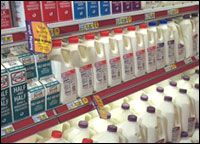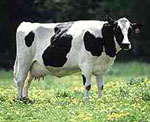Hi Umbra,
I don’t know if the same thing has happened in the U.S, but here in Canada the milk industry has undergone a massive shift to using different containers. Once, you could get plastic jugs or cardboard cartons with fold-back lids or plastic bags. But now, the most commonly available container is a revised carton. It has a plastic spout, as if pouring with the other kind were too hard.
Can you tell me which of the containers has the least impact on the environment?
Thanks,
Jessica
Creemore, Ontario, Canada
Dearest Jessica,
I hope you’ve been following our column long enough to know that your question resides in the funny little zone of trivial yet interesting environmental dilemmas. We love the funny little zone.

The milky way.
Photo: USDA.
Perhaps because I so seldom leave my beloved subterranean world, I’ve never seen milk in plastic bags. I will have to visit this strange place, Canada, and learn its customs. In the meantime, here’s the skimmy on other milk containers, as far as I could determine it. Plastic jugs are non-renewably sourced and their translucence may contribute to the degradation of nutrients in milk. The gable-top carton, as the carton with the fold-back lid is formally called, is made from paperboard sandwiched between layers of polyethylene. No wax is involved. It keeps the milk safe and healthful and is made from a renewable resource (trees). It’s also recyclable. Get this: Recycling facilities basically make carton soup in a giant blender, then sieve out the polyethylene until only a delicious creamy paper pulp remains. Try it with minced parsley. I assume that with the gable/spout combo container, the plastic bits are sieved out during the Creme du Carton process as well, but I could not find conclusive information on the subject.
So, to sum up, the traditional gable-top container is preferable to the plastic jug from a renewables standpoint, from a nutritional standpoint, and from a recycling standpoint. However, I can’t find much information about manufacturing practices or the role the spout plays in the environmental impact of the combo version.

Know your milk producer.
Photo: USDA.
And now for the priority-setting wrap-up that comes with all funny-little-zone questions. When it comes to environmentally friendly dairy consumption, the container is less important than the milk inside. Intensive containment milking operations are hard on cows, people, and nature. Although it’s difficult to verify the source of milk these days, there are some routes you can take toward supporting sustainable dairying practices. Try to buy locally produced milk so there is less associated shipping impact. Look for farms that are working to lessen their environmental impact and buy your milk there. Buying organic is always a step in the right direction if these other options aren’t feasible. If there’s an organization in your area working on sustainable agriculture issues, call it to get started on this life-changing research.
Udderly yours,
Umbra

